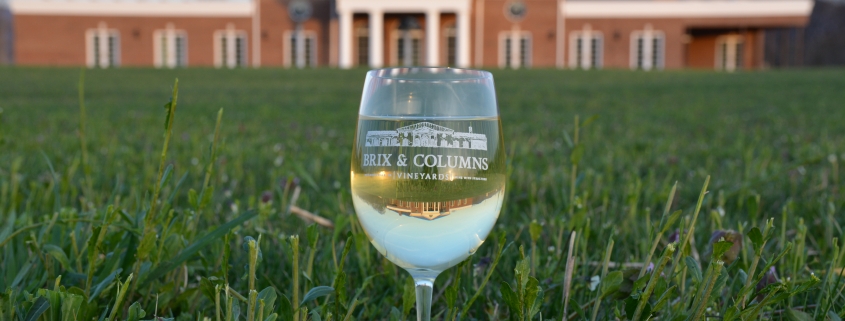What Are These Brix, Anyway?
Welcome to my blog! My name is Winston and you may see me hanging out here at Brix and Columns as I am the winery dog. They even put me on the back of the bottle! I know a lot of you have the same questions about me, so I’d like to start off telling a little about me: I am not a Holstein calf or a Dalmatian or even a miniature horse (although I weigh more than one!!) I’m a harlequin Great Dane (harlequin just means I have a black and white coat), I’m 7 years old, and I weigh 140 lbs. I am very friendly and love to be petted, but I’m almost guaranteed to leave your side when I catch sight of my mom. I love her best and I am a master at being her shadow! Oh, yes! There’s the whole “you can’t feed me” rule. I love people food, and I am really great at asking for it, but Mom says it is bad for my health and manners. Anyways, a few months ago, my people parents opened their vineyard; they named it Brix & Columns Vineyards. Makes sense to me! Lots of bricks and lots of columns- what else would they name it?
Well, turns out I was wrong and I HATE being wrong! It’s a good thing that I spend so much time in the tasting room because I am learning so much, and now, through this blog, I have a way to share it all with you. One of the very first pieces of information that made my ears perk up was when a customer asked the tasting room attendant why we chose a different spelling for the word “bricks”.
What?! Who knew there were two types of bricks? Turns out there are: bricks and Brix. Brix (°Bx) is the unit of measurement used to indicate the sweetness of grapes. Wine makers (also known as vintners) use a refractometer out in the vineyards to crush the grapes and measure the sugar levels; those sugar levels are indicated by the number of Brix assigned. This number helps them to know when to harvest the grapes. Most wine grapes are harvested between 21°Bx and 25°Bx. For a frame of reference, most table grapes that you buy at the grocery store are between 17°Bx and 19°Bx. Oh, and if the winemakers need to measure how many Brix are in the juice squeezed from the grapes, they use a hydrometer.
Why does the Brix level matter to vintners and wine lovers alike? Well, it can help wine makers determine the likely alcohol content of a dry wine when processed in the typical fashion. Roughly, each gram of sugar is converted into a half gram of alcohol. If you want to be more exact, you can multiply the Brix number by .59. For instance, a grape that is 23°Bx will produce a wine that is 13.6% alcohol.
Usually, though, wines aren’t processed in the same way at each vineyard and the final alcohol content in relation to the initial Brix level of the grapes can give wine drinkers clues about the fermentation process. If a wine has an alcohol content lower than it seems it should, according to its Brix levels at harvesting, the wine may have had some of the sweet juice drained off and replaced with water in order to make a more palatable wine. In days of old, this drained off juice was processed into Rosé wine in much the same fashion that we use to produce our own Rosé (saignée style). This technique is typically used in warm climates where the growing season produces grapes that ripen beyond the desired sweetness. One other reason a wine may have a lower alcohol content than expected is because the winemaker didn’t allow all of the sugar to ferment in order to have a sweeter wine as the finished product.
Sometimes, though, a wine has a higher alcohol content than you would expect according to the Brix levels at harvest time. In this case, the wine has been chaptalized. Chaptalization is when sugar is added (in some form, be it juice or granulated) during the fermentation process in order to create a wine with a higher alcohol content. This technique is typically used in cool climates where the growing season is not long enough to allow the grapes to ripen to their desired sweetness.
As I’m sure you can imagine, this sweet nugget of information hit me like a ton of bricks. I’m so glad I know the difference now, so I can tell all my doggie friends who come to hang out with me here at Brix and Columns!




